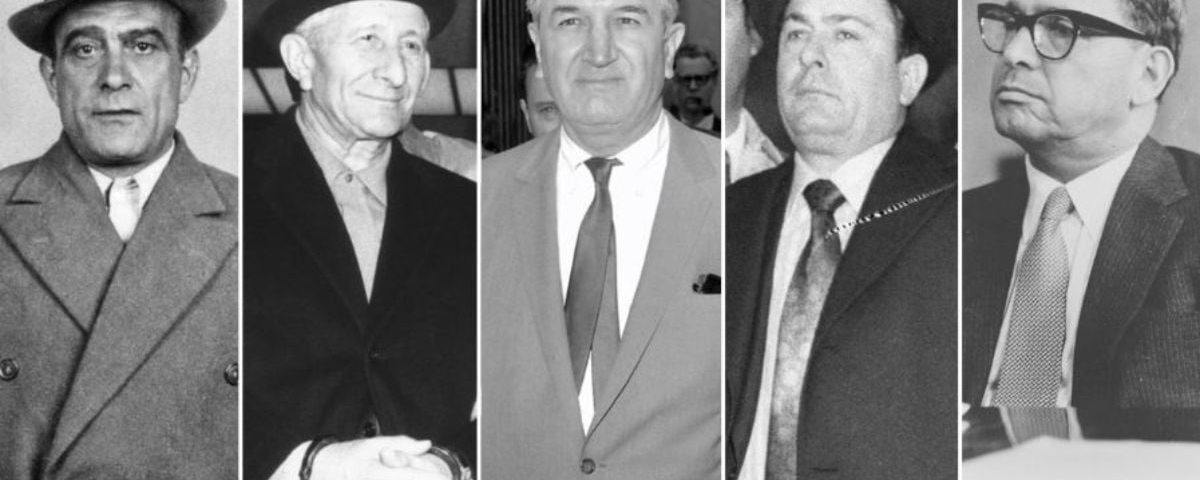
The (Real) Wild Wild West: 10 Legendary Gunslingers
November 10, 2025The meteoric rise of The Mafia in 20th Century America can be traced to two specific events: Prohibition (1920-1933) – when the (incredibly unpopular) 18th Amendment made alcohol illegal in the US, and The Great Depression (1929-1939) – the disastrous economic fallout of the infamous Stock Market Crash. Between the Roaring 20’s and WWII, organized crime flourished with mobsters gaining power and influence thanks to the Black Market of the Prohibition-era, while many an average joe turned to a life of crime out of desperation during the lowest depths of the Depression.
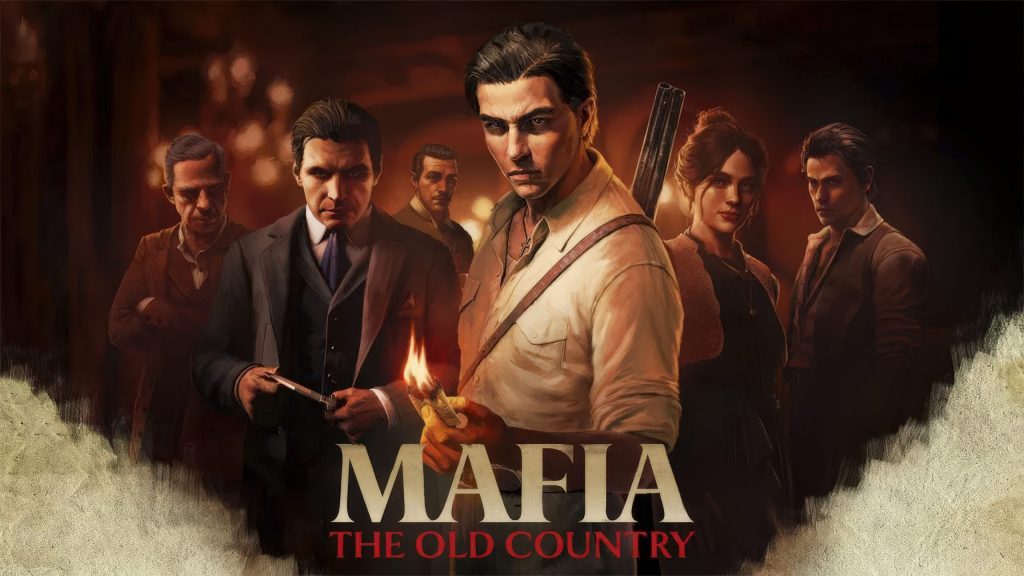
From bank robbers to bootleggers, and the Mob, these are the most infamous names in organized crime…
1 – The Newton Boys – Outlaws of the Roaring 20’s
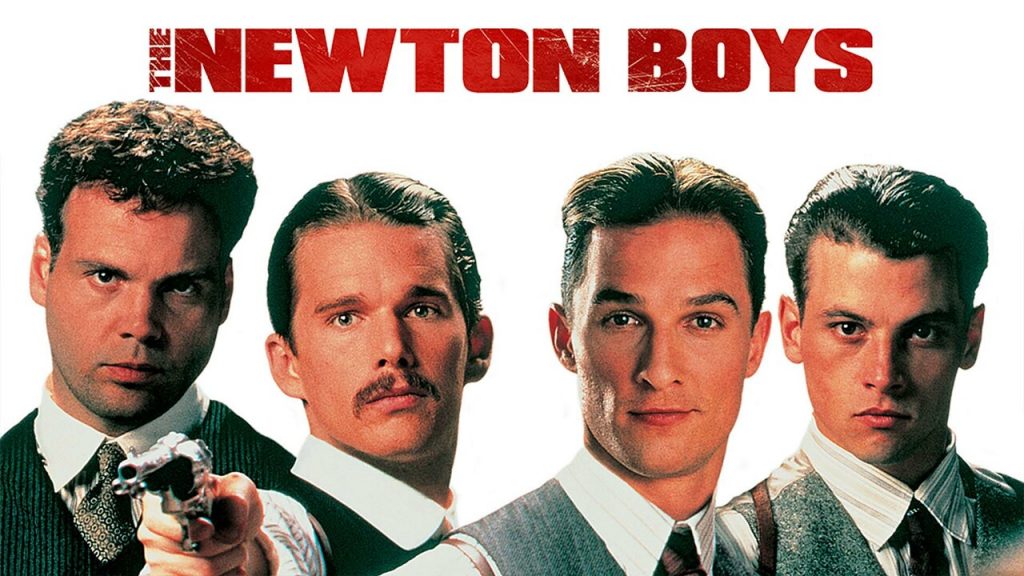
Before the rise of the Mafia in America, the early 20th Century saw the emergence of a new class of criminal – “The Newton Boys”: the most successful bank robbers in history. They were a more sophisticated, 1920’s throwback to The Wild West-era bandits (like Butch Cassidy and the Sundance Kid of ‘The Wild Bunch’), but unlike those early outlaws, these four brothers from Texas approached their escapades as a professional business… plus they had automobiles.
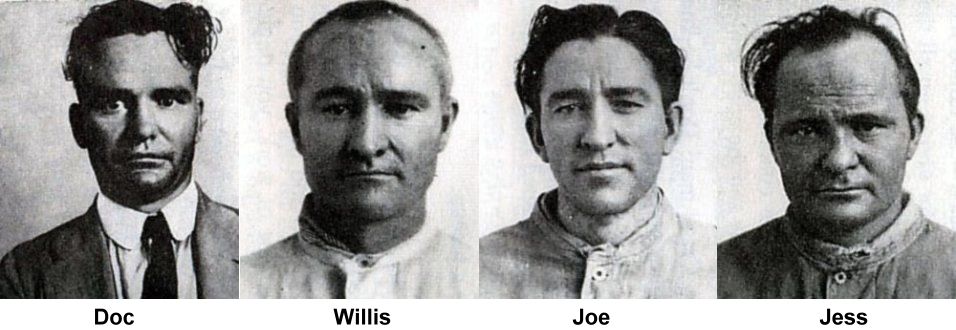
Willis, ‘Doc’, Jess, and Joe Newton grew up in Uvalde, Texas where they had a few run-ins with the law, stealing firearms, clothing, and watermelons. Willis Newton, the oldest brother and brains of the group, robbed his first bank at 25, and a few years later was roping his brothers into his operation around 1919. Joe was the youngest brother, and their getaway driver, Jess was the muscle, and Wylie “Doc” Newton was the ‘wild one’. They were often joined by their associate, Brent Glasscock, an explosives expert who was skilled at blowing safes with nitroglycerin!
 The Newton gang turned their heists into a family trade with a few key rules: No drinking on the job, they only worked at night, cash only, and no killing. They operated primarily in the Mid-West, in the early 1920’s, robbing a total of 75 banks and six trains across 10 states (and Canada) – without killing anyone! Their biggest score however was in 1924, in Illinois, The Rondout Train Robbery, the largest train robbery in American history! With the help of a corrupt postal inspector and a Chicago racketeer, the gang successfully managed to hijack a mail train carrying $3 million in cash, bonds, and jewelry! (the equivalent of $50 million today!)
The Newton gang turned their heists into a family trade with a few key rules: No drinking on the job, they only worked at night, cash only, and no killing. They operated primarily in the Mid-West, in the early 1920’s, robbing a total of 75 banks and six trains across 10 states (and Canada) – without killing anyone! Their biggest score however was in 1924, in Illinois, The Rondout Train Robbery, the largest train robbery in American history! With the help of a corrupt postal inspector and a Chicago racketeer, the gang successfully managed to hijack a mail train carrying $3 million in cash, bonds, and jewelry! (the equivalent of $50 million today!)
Unfortunately, they got sloppy – while firing tear gas and bullets, Doc was hit in the leg and badly injured, and an innocent bystander heard them shout “Willie!” which later gave authorities the clue they needed to track down the outlaws, after a lead led them to a house in Chicago where an injured man was being treated for a gunshot wound. Three of the brothers were promptly arrested, while Jess fled for Texas with $35,000, but got sloshed drunk in San Antonio, decided to bury his stolen loot like a pirate, and promptly blacked out, and completely forgot where he buried the cash! He then crossed the border into Mexico where he was immediately arrested by a Federal Agent.
All four brothers served hard time, and eventually returned to their hometown in Texas where they (mostly) lived quiet, law-abiding lives, except for that one time Doc made a bungled attempt at robbing a bank *in his mid-70’s* in 1968! Willis was also implicated in a bank robbery in 1973, but there wasn’t enough evidence to prove a case against him. Meanwhile, Joe Newton appeared on “The Tonight Show starring Johnny Carson” to talk about his life as an outlaw in 1980 and even started up a cafe in Uvalde, living until 1989, when he died at the ripe old age of 88. Their saga eventually inspired a movie in 1998, starring Matthew McConaughey, Ethan Hawke, and Vincent D’Onofrio!
2 – Al Capone – “Scarface”

Al Capone is of course the single most famous American gangster in history, a ruthless man who built an enormous criminal empire as a Prohibition-era mob boss in 1920’s Chicago, amassing vast amounts of wealth and power through gambling, bootlegging, and of course extreme violence.
Born in Brooklyn as Alphonse Gabriel Capone to Italian immigrants in 1899, he was a troubled kid who once got expelled from Catholic School after literally punching a nun in the face! He worked a few odd jobs including a bowling alley and a candy store before becoming a bouncer for a Coney Island dance hall, in 1917, where he once insulted a woman whose brother then slashed him in the face with a knife, leading to his now iconic nickname “Scarface”. He was reportedly very self-conscious of the scars, referring to them as ‘war wounds’, and would often be particular about photographers getting his ‘good side’. (Funnily enough, he hated the name ‘Scarface’, and instead preferred to be called “Snorky”… seriously lol)

Not to be confused with the (fictional) cocaine-fueled 80’s Cuban gangster.
Capone eventually became acquainted with his mentor, fellow gangster Johnny “The Fox” Torrio, who gave him a job offer he couldn’t refuse in Chicago, working for James “Big Jim” Colosimo aka “Diamond Jim”, in 1919. Al got a job as a bouncer for one of Big Jim’s brothels where he promptly contracted syphilis, but apparently never sought treatment leading to a number of severe symptoms later on in life. The very next year, Torrio’s boss (Big Jim Colosimo), died under mysterious circumstances, leaving the “Chicago Outfit”, the South-Side Gang, his entire prostitution ring, and his entire bootlegging operation to him. Then in 1925, after an attempted assassination, Johnny ‘The Fox’ retired from the business, handing the reigns of his network of organized crime over to Al.
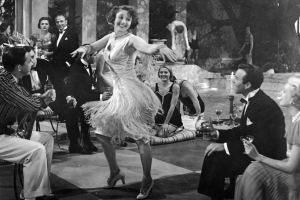 Under Capone, the Chicago Outfit became a multi-million-dollar industry, running the entire city’s liquor supply and gambling operations at a number of speakeasies, enforced by a private army of gunmen. During Prohibition, Chicago’s nightclubs quickly became all he rage throughout the “Roaring 20’s”, and mobsters like Capone took full advantage of the situation. To his credit, Capone often hired members of the black community at his clubs, and helped to turn Chicago into a thriving music scene for jazz musicians. Meanwhile, Al indulged in cigars, alcohol, food, and women, often wearing custom suits and costly, flamboyant jewelry. He was quoted as boasting, “I am just a businessman, giving the people what they want. All I do is satisfy a public demand.”
Under Capone, the Chicago Outfit became a multi-million-dollar industry, running the entire city’s liquor supply and gambling operations at a number of speakeasies, enforced by a private army of gunmen. During Prohibition, Chicago’s nightclubs quickly became all he rage throughout the “Roaring 20’s”, and mobsters like Capone took full advantage of the situation. To his credit, Capone often hired members of the black community at his clubs, and helped to turn Chicago into a thriving music scene for jazz musicians. Meanwhile, Al indulged in cigars, alcohol, food, and women, often wearing custom suits and costly, flamboyant jewelry. He was quoted as boasting, “I am just a businessman, giving the people what they want. All I do is satisfy a public demand.”
Other notable bootleggers of the 1920’s included: Jewish gangster Dutch Schultz, Joey Noe, Frankie Dunn, and Irish mobster Jack “Legs” Diamond, but the only one to challenge Capone’s turf was his rival, George Clarence “Bugs” Moran. Bugs Moran’s predecessor, Dean O’Banion, had been gunned down by Torrio’s gang, so there was beef. Plus, Bugs was a deeply religious Catholic and saw Capone’s prostitution business as immoral and offensive. Bugs even made an attempt on Al’s life where more than one-thousand shots were fired at the Hawthorne Inn, Capone’s HQ in Cicero. Everything came to a head in 1929, when Al Capone orchestrated what’s now known as the St. Valentine’s Massacre…
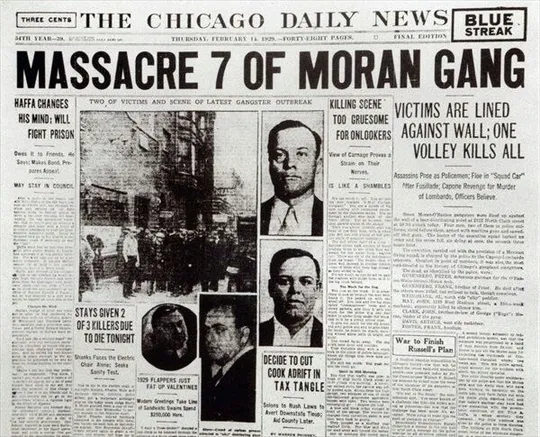
On February 14th, 1929, while Capone was (conveniently) away in Miami, Florida, several of his men, disguised as police officers, managed to surprise and execute seven members of Bus Moran’s North-Side Gang, brutally mowing them down against a brick wall in an alleyway. One of the critically wounded gangsters was asked, “Who shot you?” to which he responded, “No one… no one shot me.” before dying.
 For years, Al Capone was untouchable, despite all the blatant corruption, car bombs, and violent killings, he always seemed to avoid prosecution. Elliot Ness and his team attempted to indict Capone on 5,000 violations of the Volstead Act in 1931, but between bribing police, or intimidating witnesses, authorities could never seem to connect him to any concrete evidence. The US government couldn’t seem to nab him on liquor charges, or any of the various murders he was behind, so they instead turned to a Hail Mary of a pass: tax fraud.
For years, Al Capone was untouchable, despite all the blatant corruption, car bombs, and violent killings, he always seemed to avoid prosecution. Elliot Ness and his team attempted to indict Capone on 5,000 violations of the Volstead Act in 1931, but between bribing police, or intimidating witnesses, authorities could never seem to connect him to any concrete evidence. The US government couldn’t seem to nab him on liquor charges, or any of the various murders he was behind, so they instead turned to a Hail Mary of a pass: tax fraud.
On October 17th, 1931, Al Capone was convicted on 3 of 22 counts of tax evasion, and sentenced to 11 years in prison. He was eventually moved from a prison in Atlanta, Georgia to the newly opened federal penitentiary on Alcatraz Island, in California’s San Francisco Bay, in 1934. He was released in 1939, due to his significantly deteriorating health from his advanced and untreated syphilis, leaving him mentally incapacitated, now a sad shadow of his former self, reduced to the mentality of a child.
He died at his mansion in Florida, in 1947, at the age of 48, surrounded by family.
3 – Charles “Lucky” Luciano and the Five Families
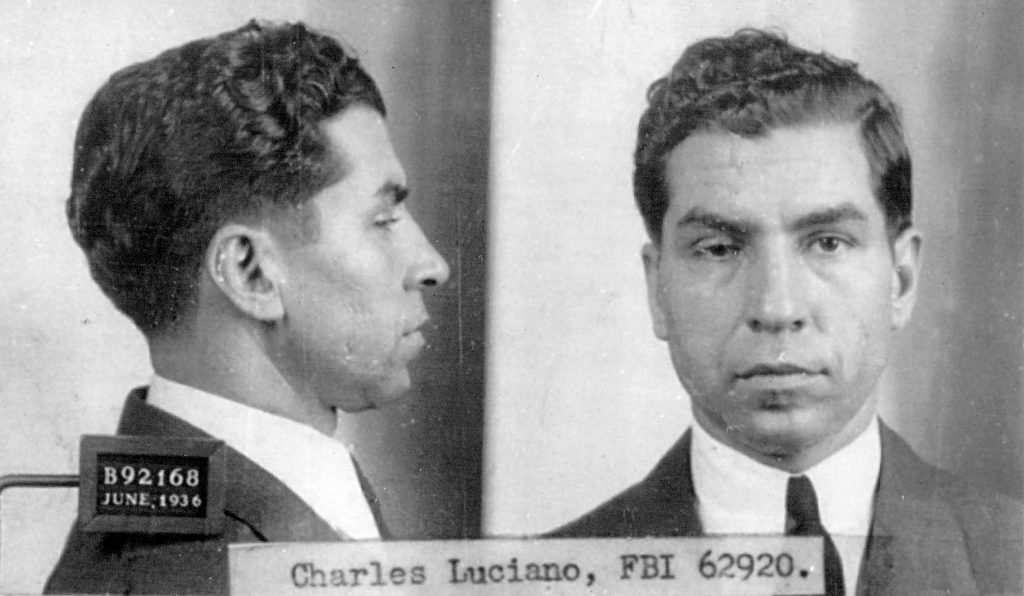
Charles “Lucky” Luciano is considered to be one of the most central figures in the history of the American Mafia, working closely with his close associates Frank Costello and Meyer Lansky. Under his leadership, organized crime evolved into more than just a family business, it became an enterprise.
Charles Luciano was born in Italy, as Salvatore Lucania, and immigrated to the US where his family settled in the Lower-East Side of Manhattan, New York in 1906, when he was 8 years old. At 14, he dropped out of school and began hustling and gambling. He started his own street gang as a teenager, and offered protection to Jewish youngsters from the local Italian and Irish gangs. He first met his good buddy, Meyer Lansky when he attempted to extort him for protection money on his walk home from school, and respected him for standing up to him.
It’s unclear when or why he got his nickname “Lucky” Luciano, whether it was his incredible luck at gambling, all of his lucky breaks with the law (he was arrested 25 times from 1916 to 1936 and somehow spent zero time in prison), or his unique ability to survive multiple assassination attempts, but its pretty clear that he definitely earned the title.
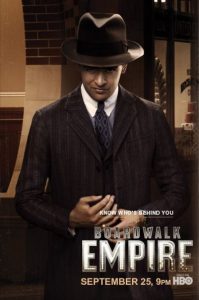 In the 1920’s, he was hired as a gunman for Giuseppe “Joe the Boss” Masseria, and got into the bootlegging business with Vito Genovese (more on him later), and made connections with Albert Anastasia (also covered later). Joe the Boss Masseria’s had a brewing rivalry (no pun intended) with the Castellammarese clan, led by Sicilian boss, Salvatore Maranzano. Masseria and Maranzano were considered part of the “Old World Mafia”, while they professed principles of honor, tradition, and respect, they were also super racist against non-Italians. Lucky Luciano saw these old school ‘conservative’ mobsters as rigid and inefficient, and felt like it was time for a change.
In the 1920’s, he was hired as a gunman for Giuseppe “Joe the Boss” Masseria, and got into the bootlegging business with Vito Genovese (more on him later), and made connections with Albert Anastasia (also covered later). Joe the Boss Masseria’s had a brewing rivalry (no pun intended) with the Castellammarese clan, led by Sicilian boss, Salvatore Maranzano. Masseria and Maranzano were considered part of the “Old World Mafia”, while they professed principles of honor, tradition, and respect, they were also super racist against non-Italians. Lucky Luciano saw these old school ‘conservative’ mobsters as rigid and inefficient, and felt like it was time for a change.
In 1929, Luciano held a conference in Atlantic City with several big names in the mob world, including ‘wise guys’ like Frank Costello, Meyer Lansky, and Johnny ‘The Fox’ Torrio, where he laid out his vision to form a Crime Syndicate in which the Italians, Jews, and Irish gangs could pool their resources together as one cohesive national network. The Sicilian leaders got wind of this and saw Luciano and his ‘progressive ideals’ as a threat to be dealt with.
 One night, Lucky was accosted by three men at gunpoint, forced into a limousine, before he was strung up by his hands in a Staten Island warehouse where he was beaten, stabbed multiple times, and even had his throat slit, leaving him for dead. He miraculously survived the ordeal, but was permanently scarred. Lucky told the cops that he had no idea who did it, but he had his suspicions.
One night, Lucky was accosted by three men at gunpoint, forced into a limousine, before he was strung up by his hands in a Staten Island warehouse where he was beaten, stabbed multiple times, and even had his throat slit, leaving him for dead. He miraculously survived the ordeal, but was permanently scarred. Lucky told the cops that he had no idea who did it, but he had his suspicions.
The following year, in 1930, a brutal mob war broke out between Joe the Boss and Salvatore Maranzano for control of New York’s underworld (“The Castellammarese War” ), while Lucky Luciano secretly played both sides, plotting against them. Lucky orchestrated the murder of his own boss in a Coney Island restaurant, before assembling a hit team to take out Salvatore, in his own office, after crowning himself “Boss of all Bosses”.
In the aftermath of the bloody power struggle, with the old regime wiped out, Charles ‘Lucky’ Luciano established ‘The Commission’, leading to the formation of “The Five Families”, in 1931, which essentially included what would come to be known: the Bonanno, Colombo, Gambino, Genovese, and Lucchese families, as well as Al Capone’s Chicago Outfit.

Following Lucky’s immense power play, he became a target for New York prosecutor Thomas E. Dewey who successfully convicted him on prostitution charges, and he was sentenced to 50 years in prison! As luck would have it however (pun intended), he was pardoned during World War II, because the US government sought help from the Mafia to secure New York’s waterfront against any potential Nazi sabotage. The mob leader was also instrumental in providing intelligence for the 1943 Invasion of Sicily (ironically named, “Operation Underworld”). After which he was deported back to Italy in 1946, where he lived out the rest of his life, dying from a heart attack in 1962 while planning to meet with an American film producer.
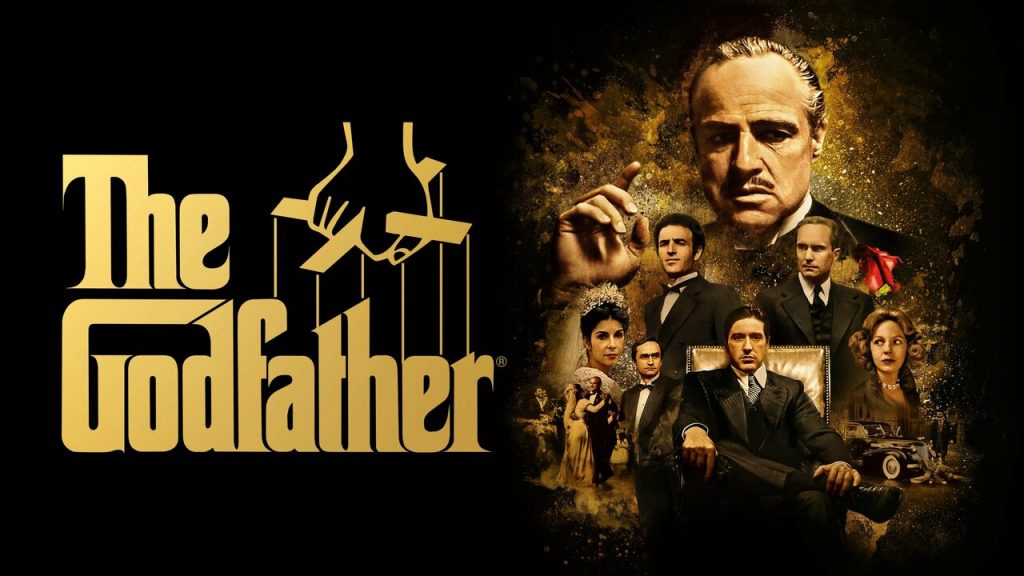
Fun side note: Luciano’s underling, Frank Costello (often referred to as ‘the power behind the throne’), was the primary inspiration for Marlon Brando’s Vito Corleone in Francis Ford Coppola’s “The Godfather” (1972).
4 – Vincent “Mad Dog” Coll

Born in 1908, Vincent “Mad Dog” Coll was an Irish-American mob enforcer in Prohibition-era New York in the late 20’s and early 30’s, who grew up in the harsh slums of the Bronx before carving out a living working for Jewish mobster, Dutch Schultz and his extensive bootlegging operation.
Unlike a lot of professional hitmen, who were careful and focused solely on their target, Vincent Coll was a psychotic killer whose unpredictable and reckless attacks often resulted in the deaths of innocent bystanders caught in the crossfire, earning him the title “Mad Dog” from the New York press. He was basically the exact kind of low-level Gotham City thug that Batman has been punching off roof tops since 1939.
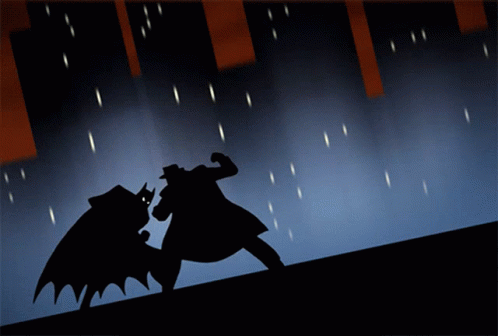
In 1931, at just 22 years old, Mad Dog had a falling out with Shultz over a financial dispute, and decided to form his own gang, which quickly devolved into a bloody gang war between the two. Things took a turn for the worst however when Coll and his thugs attempted to kidnap rival mobster Joey Rao. As Joey attempted to get away, Vincent opened fire, spraying a parked car with bullets. Rao managed to got away, but during the chaos, one of the bullets struck and killed a 5-year-old kid named Michael Vengalli!
The public, the police, and even the criminal underworld were all horrified by the incident. Coll was labeled a “Baby Killer” and the Mayor of New York City, Jimmy Walker publicly decried that “Mad Dog” needed to be “put down”. The police launched an unprecedented manhunt to capture Mad Dog Coll, but due to a lack of credible witnesses, he was acquitted of manslaughter. Dutch Schultz meanwhile decided to take the law into his own hands, and hired a top assassin to finish the job.
On February 8th, 1932, at a drug store on Eight Avenue in Manhattan, Vincent Coll was making a call in a phone booth, when a black limousine pulled up. Before Mad Dog could react, a mob lieutenant riddled him with 16 bullets from a Thompson submachine gun, forever sending a message to anyone who dared to cross that line again…

5 – John Dillinger and “Baby Face Nelson” – Public Enemies
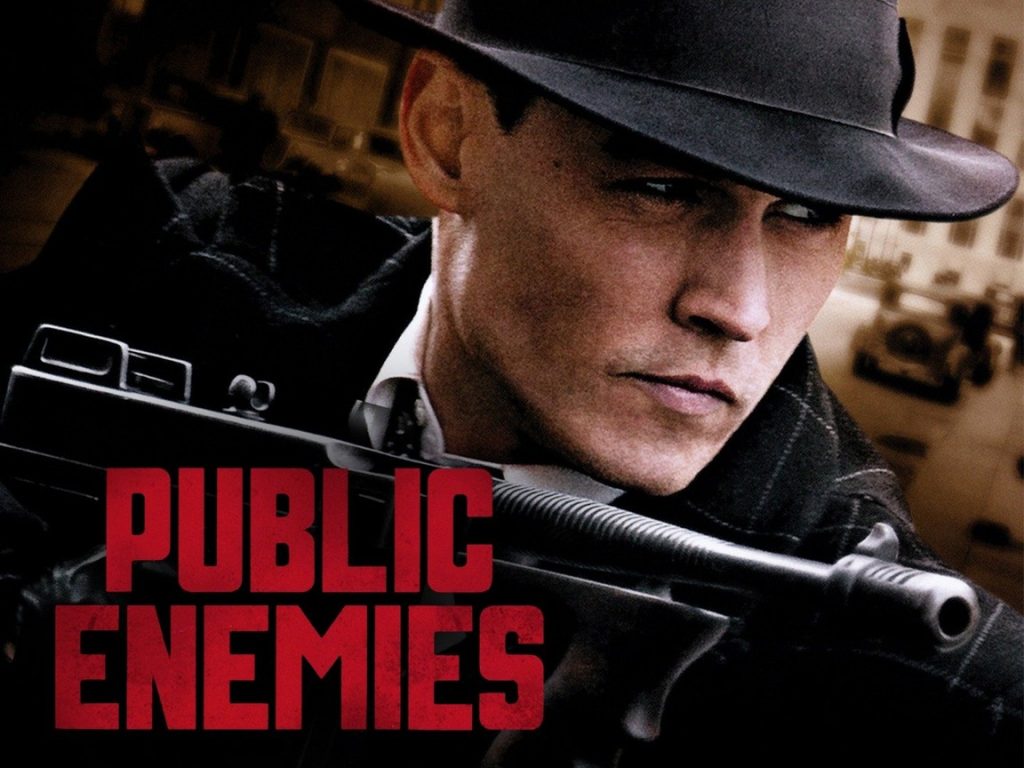
John Herbert Dillinger, Jr and Lester Joseph “Baby Face Nelson” Gillis were two of the most notorious outlaws operating during the Great Depression, with both being listed as the FBI’s “Public Enemy #1”.
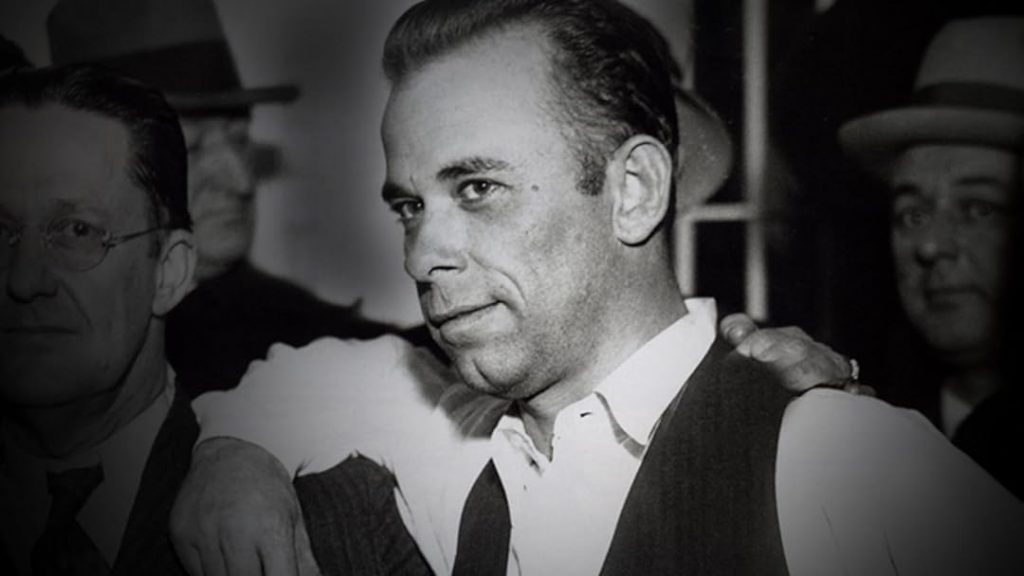
John Dillinger
Born in 1903, John Dillinger had a history of petty theft as a kid, which soon escalated to auto theft in 1922, and after a dishonorable discharge from the Navy for deserting, he wasn’t able to land a job, so (naturally) he turned to crime. In 1923, he was convicted of assault and battery, with intent to rob, and conspiracy to commit a felony, after robbing a grocery store for $50, which sent him away for the next 10 years. During his time in prison, he made connections with other criminals. When he was released back on the streets, in 1933, with the economy in the toilet, his only job prospect was robbing banks. During his escapades, Dillinger robbed twenty-four banks and four police stations, and escaped prison twice! His most famous and daring escape involved a carved wooden gun which he used to break out of a jail in Crown Point, Indiana, in 1934.
 Among his ever-rotating gang members (which included such hardened crooks as Homer Van Meter, Harry Pierpont, and John “Red” Hamilton), one of the most notable was of course “Baby Face Nelson”. Unlike Dillinger who was well-dressed, handsome, and had a suave and charming personality that made him a celebrity, Nelson was a ruthless, cold-blooded killer with an unpredictable and explosive temper. Baby Face was by far the most dangerous member of Dillinger’s inner circle, who earned his ironic moniker due to his youthful appearance and short stature (5’4).
Among his ever-rotating gang members (which included such hardened crooks as Homer Van Meter, Harry Pierpont, and John “Red” Hamilton), one of the most notable was of course “Baby Face Nelson”. Unlike Dillinger who was well-dressed, handsome, and had a suave and charming personality that made him a celebrity, Nelson was a ruthless, cold-blooded killer with an unpredictable and explosive temper. Baby Face was by far the most dangerous member of Dillinger’s inner circle, who earned his ironic moniker due to his youthful appearance and short stature (5’4).
Baby Face Nelson and the Dillinger Gang ended up attracting the attention of the newly formed FBI (The Federal Bureau of Investigations) under J. Edgar Hoover. This investigation, led by Melvin Pervis (who also hunted down “Pretty Boy Floyd” after the Kansas City Massacre), culminated with the Little Bohemia Lodge Shootout in 1934, when FBI Agents surrounded the gang at their hideout. Baby Face, armed with a machine gun, shot his way out, killing multiple Federal Agents, and giving Dillinger and his pals a chance to escape. After several violent fits of rage from Nelson (which usually ended with a trial of bodies), Dillinger parted ways, refusing to rob banks with the unhinged psychopath, because it was hurting his image.
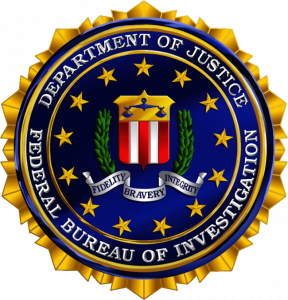
Dillinger’s luck finally ran out however on July 22nd, 1934, after attending Chicago’s Biograph Theater with Anna Sage aka the “Woman in Red”, when he was ambushed by Federal Agents. John Dillinger attempted to flee down an alleyway and was gunned down by three men: Clarence Hurt, Charles Winstead, and Herman Hollis. He was struck four times, with the fatal bullet entering the back of his neck and exiting just under his right eye, killing him.
The FBI then focused its efforts on his associate, Baby Face Nelson who was responsible for the deaths of numerous Agents, and was now America’s most wanted man. Nelson was spotted in Barrington, Illinois, driving a stolen car. Nelson engaged Federal Agents in a massive shootout that ended with two Special Agents fatally wounded (Samuel Cowley and Herman Hollis), and Nelson himself critically wounded, dying later that night.
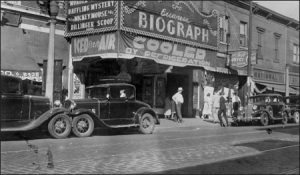
These events were the inspiration for the 2009 movie, “Public Enemies” starring Johnny Depp as John Dillinger, and Christian Bale as Baby Face Nelson.
In the end, both John Dillinger and Baby Face Nelson died the way they lived, violently…
6 – Bonnie and Clyde

During the height of the Great Depression, Bonnie Elizabeth Parker and Clyde Chestnut Barrow went on a two-year crime spree that immortalized the star-crossed lovers as mythic figures among some of the most notorious gangsters in American history.
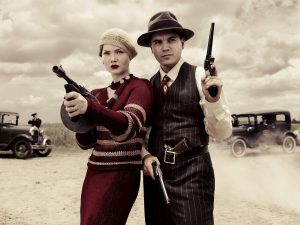 Both Bonnie Parker and Clyde Barrow were born into poverty in Texas. At just 19 and 20, the two love birds met in Dallas in 1930 and their love-at-first-sight sparks soon turned into machine-gun fire as they soon took up a life of crime as a dynamic duo! Among the extreme economic hardship of the Depression, the public romanticized their exploits as “Robin Hood”-style anti-heroes, even though most of their victims were everyday gas station attendants, and poor shopkeepers.
Both Bonnie Parker and Clyde Barrow were born into poverty in Texas. At just 19 and 20, the two love birds met in Dallas in 1930 and their love-at-first-sight sparks soon turned into machine-gun fire as they soon took up a life of crime as a dynamic duo! Among the extreme economic hardship of the Depression, the public romanticized their exploits as “Robin Hood”-style anti-heroes, even though most of their victims were everyday gas station attendants, and poor shopkeepers.
The couple started up “The Barrow Gang”, which included Clyde’s older brother, Marvin “Buck” Barrows, along with his wife Blanche, as well as Raymond Hamilton and W.D. Jones. Clyde Barrow was the undisputed leader of the gang, and getaway driver who was known for his penchant for Browning Automatic Rifles, and had a habit of stealing Ford V8 cars. Contrary to the urban myths, the Barrow Gang were largely unsuccessful, small-time crooks, with their largest bank robbery netting them around $1,500, while they typically preferred to knock over grocery stores.
 Starting in 1932, the pair swept across the mid-west on a ruthless crime spree that claimed the lives of 9 police officers and 3 civilians over the course of 21 months. The two gained national notoriety when police discovered a roll of undeveloped film at one of their hideouts in Missouri – the Instagram-worthy pics showed the couple posing with shotguns and cigars.
Starting in 1932, the pair swept across the mid-west on a ruthless crime spree that claimed the lives of 9 police officers and 3 civilians over the course of 21 months. The two gained national notoriety when police discovered a roll of undeveloped film at one of their hideouts in Missouri – the Instagram-worthy pics showed the couple posing with shotguns and cigars.
After they helped five inmates escape in Waldo, Texas, in which two guards were killed, a nation-wide manhunt began for Barrow and Parker, in 1934. Things continued to escalate as they killed two more officers and a police constable, as well as kidnapping a police chief! Ultimately, they were betrayed by a friend, Henry Methvin, who ratted them out to the cops. Retired Texas Ranger Frank Hamer and Louisiana Sheriff Henderson Jordan coordinated an ambush on a deserted stretch of highway south of Arcadia, Louisiana, on May 23rd, 1934, and assembled a six-man posse to take down Bonnie and Clyde.
A trap was set, with Methvin’s truck parked off the side of the road as if he was exchanging a flat tire, while officers hid behind the bushes on the other side of the road. Clyde’s (stolen) Ford V8 appeared and slowed down as they approached the seemingly stranded truck. Suddenly, they were surprised by a road block, and attempted to flee past it when the police opened fire. 130 rounds of ammunition were pumped into the side of the car, killing the outlaw couple instantly…

Hollywood later revitalized their story in the 1967 film, “Bonnie and Clyde”, starring Warren Beatty as Clyde, Faye Dunaway as Bonnie, and Gene Hackman as Buck, forever cementing their status as American icons.
7 – Machine Gun Kelly – The Crime of the Century?
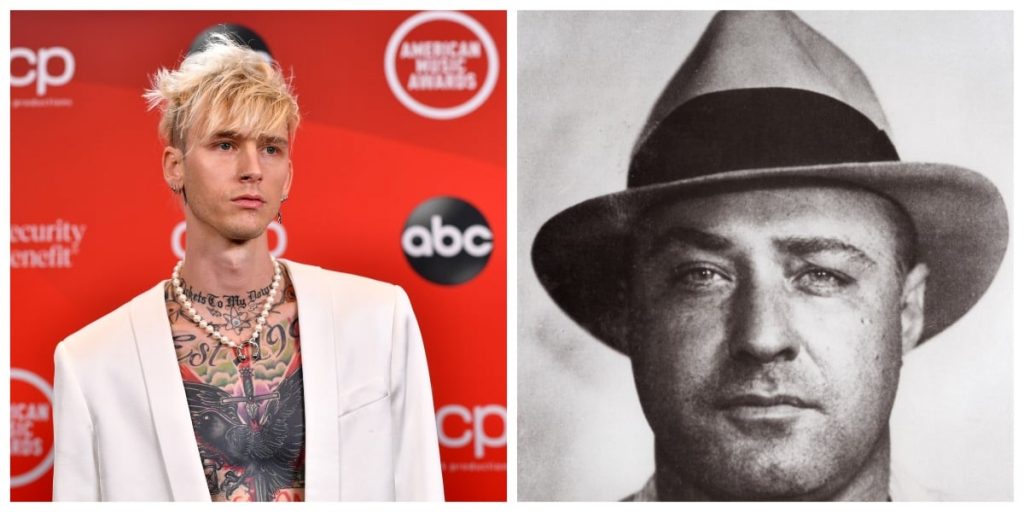
Not to be confused with the rapper of the same name.
George “Machine Gun” Kelly Barnes was yet another Prohibition-era gangster, but he wasn’t exactly the ‘cold blooded killer’ that his nickname suggests. In fact, Machine Gun Kelly never actually killed anyone in his entire criminal career!
Kelly was a college drop-out from a wealthy family in Memphis, Tennessee, who turned to bootlegging in the 1920’s, changing his name to George R. Kelly to avoid law enforcement and protect his loved ones. In 1928, he was arrested in Tulsa, Oklahoma for smuggling liquor onto an Indian reservation. Shortly after getting out of prison, he hooked up with Kathryn Thorne, a professional criminal in her own right, and the two started up a new gig as bank robbers.
 After getting hitched, Kathryn decided George needed a rebranding in order to stand out in the criminal underworld, so she bought him a Tommy Gun, encouraging him to do target practice in the countryside. She even handed out spent shell casings to associates as “souvenirs” from her “dangerous” husband, who secretly could care less about weapons. Thanks to her manipulative scheme, “Machine Gun Kelly” became a stone-cold killer, feared by the public and mobsters alike. According ton the urban legend he could write his name on a barn wall with bullets – but it was all a PR scheme!
After getting hitched, Kathryn decided George needed a rebranding in order to stand out in the criminal underworld, so she bought him a Tommy Gun, encouraging him to do target practice in the countryside. She even handed out spent shell casings to associates as “souvenirs” from her “dangerous” husband, who secretly could care less about weapons. Thanks to her manipulative scheme, “Machine Gun Kelly” became a stone-cold killer, feared by the public and mobsters alike. According ton the urban legend he could write his name on a barn wall with bullets – but it was all a PR scheme!
In addition to robbing banks together, George and Kathryn realized they could make even more through ransoming hostages. You see, during the Great Depression, kidnapping became all the rage, with one of the most famous cases being the case of the Lindbergh Baby, which captured the public’s imagination at the time. So in 1932, Kelly and his wife conspired with fellow gangster, Eddie Doll, to abduct Howard Arthur Woolverton, a wealthy manufacturer from Indiana, who they successfully ransomed for $8,000 (after negotiating down from $50,000), before releasing him, safely, 24 hours later.
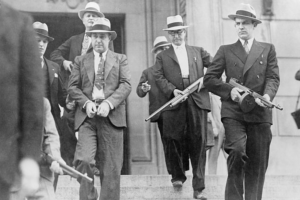 Following this ‘success’, the Kelly’s were riding high on a false sense of security, and decided to up the stakes. This time, in 1933, they targeted a wealthy oil tycoon from Oklahoma City, Charles F. Urschel. Machine Gun Kelly and his cohorts snatched up Charles during a bridge game, holding him up at (machine) gun point, and forced him into the back of their Chevrolet. They drove him out to Kathryn’s mom’s farm in Texas, where they ransomed him for $200,000! ($4.9 million today!) The gangsters held Urschel hostage for a week, and let him free once the ransom was paid.
Following this ‘success’, the Kelly’s were riding high on a false sense of security, and decided to up the stakes. This time, in 1933, they targeted a wealthy oil tycoon from Oklahoma City, Charles F. Urschel. Machine Gun Kelly and his cohorts snatched up Charles during a bridge game, holding him up at (machine) gun point, and forced him into the back of their Chevrolet. They drove him out to Kathryn’s mom’s farm in Texas, where they ransomed him for $200,000! ($4.9 million today!) The gangsters held Urschel hostage for a week, and let him free once the ransom was paid.
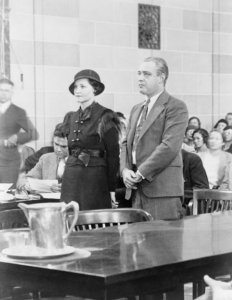
What they didn’t count on was Urschel memorizing details about his captivity (the sounds of farm animals, textures on the wall, and even the exact times he heard planes flying) – all details which he relayed to authorities. The FBI managed to use flight logs to pinpoint the farm that he was held at, and with a couple months had tracked down George ‘Machine Gun’ Kelly and his wife, Kathryn to their safe house in Memphis! The FBI Agents kicked down the door, and (according to legend), Kelly threw up his hands shouting, “Don’t shoot, G-Men! Don’t shoot!” During the raid, both George and his wife were arrested. They were both tried and sentenced to life in prison under the recently passed Lindbergh Law, which made kidnapping a serious federal crime.
Machine Gun Kelly was sent to Alcatraz as inmate #117, where he would spend the rest of his life for 21 years. While in Alcatraz, he quickly became known as “Pop Gun Kelly” due to his mild nature, and despite exaggerated stories of his past as a ruthless gangster, was a model prisoner who even served as an altar boy in the prison’s chapel. He died of a heart attack on his 59th birthday, in 1954…
7 – Benjamin “Bugsy” Siegel – The Godfather of Las Vegas

Benjamin Siegel was born in the slums of Brooklyn, the son of Jewish immigrants from Ukraine. Like many mobsters, he grew up in poverty, dropped out of school, and immediately joined a street gang in his teenage years. He would intimidate push-cart peddlers for “protection money”, when they asked why – he would promptly pour kerosene on their push carts and set them on fire. Later, when he joined the mob as a car thief, bootlegger, and part-time hitman, other gangsters called him “Bugsy” (meaning “as crazy as a bed bug”) behind his back, because of his violent temper. No one dared called him that to his face, unless they had a death wish.
During his East Coast years, Bugsy teamed up with Meyer Lansky, and the two wreaked havoc as a duo, with Lansky as “the brains” and Siegel as “the brawn”. It’s estimated that he killed over 30 people while working under Lucky Luciano. He was also instrumental in the murders of rival mob bosses, “Joe The Boss” Masseria, and Salvatore Maranzano (see above), and as a result, quickly rose through the ranks of the mafia. So in the 1930’s, the syndicate sent Bugsy Siegel to Los Angeles, California to oversee their lucrative West Coast operations: gambling ships, wire services, and the drug trade.
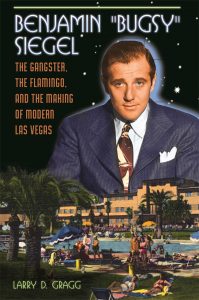
While in LA, Siegel lived the highlife in the spotlight, dressed to the nines, and even bought a mansion in Beverly Hills! Because of his handsome looks and charming persona, he quickly became a celebrity socialite who befriended some of the biggest names in Hollywood at the time, including George Raft, Jean Harlow, and Cary Grant! Despite being married, he took Virginia Hill as his mistress, who later became famous in her own right. In 1939, Mickey Cohen, a former bootlegger from Al Capone’s Chicago Outfit (and future Sunset Strip Kingpin) was sent to work with Siegel, and the two worked closely together over the next few years.
Then, in the 1940’s, the mafia had a new job for Bugsy, they sent him to Las Vegas, Nevada (a small up and coming city in the middle of the desert at the time) to scout potential gambling prospects. It was in Las Vegas that Bugsy Siegel found his true calling, he instantly saw the enormous potential of the town, and convinced his fellow mobsters to throw in funding for their own casino. With backing from the Five Families, Bugsy financed the construction of The Flamingo – an extravagant hotel and casino – the first of its kind! Bugsy’s vision for Vegas helped transform the city from a dusty western town into a luxury resort destination over night, moving away from the sawdust-floor gambling halls of the Wild West to the carpeted, neon-lit palaces they are today.
When the original developer of The Flamingo, Billy Wilkerson (owner of the Hollywood Reporter) ran out of money, Siegel stepped in, and took over the project. He spared no expense, demanding the finest materials (in a time of post-war scarcity), and even installed a secret escape ladder in his presidential suite! As a result, construction costs ballooned from $1.5 to $6 million, and the mob started to get nervous, and he was accused of incompetence and skimming money from them.
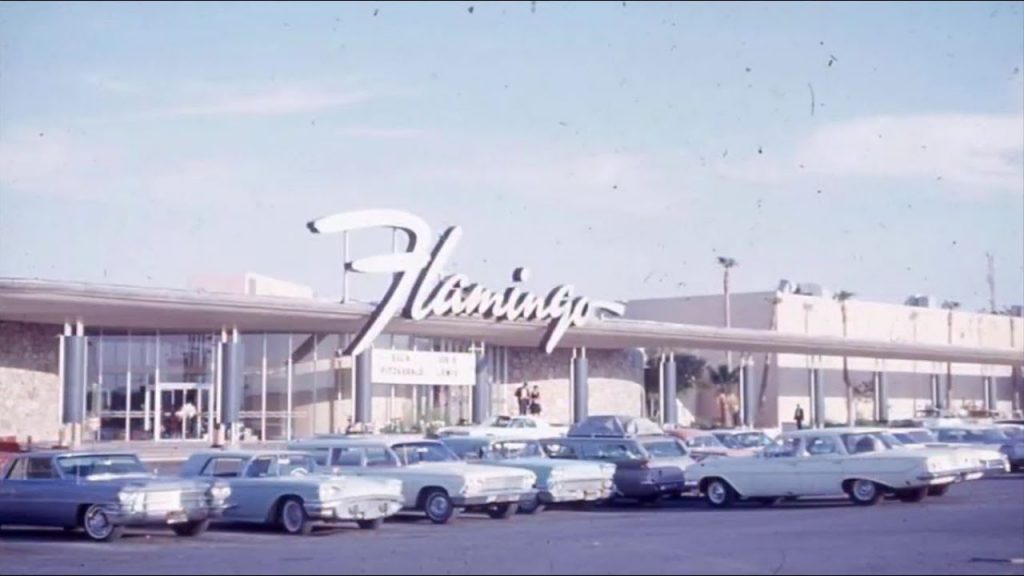
In 1946, a conference was held in Havana, Cuba where several mob bosses met to discuss what to do about the Vegas situation, while Lansky begged the dons to give them more time to turn a profit. If this series of events sounds familiar, it’s because it was the basis for a significant plot point in “The Godfather – Part II” (1974).
On June 20th, 1947, Benjamin ‘Bugsy’ Siegel’s time ran out. While sitting on a sofa, reading the paper, in Virginia’s Beverly Hills home, an unknown assassin fired an M1 carbine through the window. He was riddled with bullets, with two shots to the head killing him on impact, and blowing his left eye out of its socket! Minutes later, two mob associates, Gus Greenbaum and Moe Sedway, casually walking into The Flamingo hotel and casino, announcing they were taking over operations.
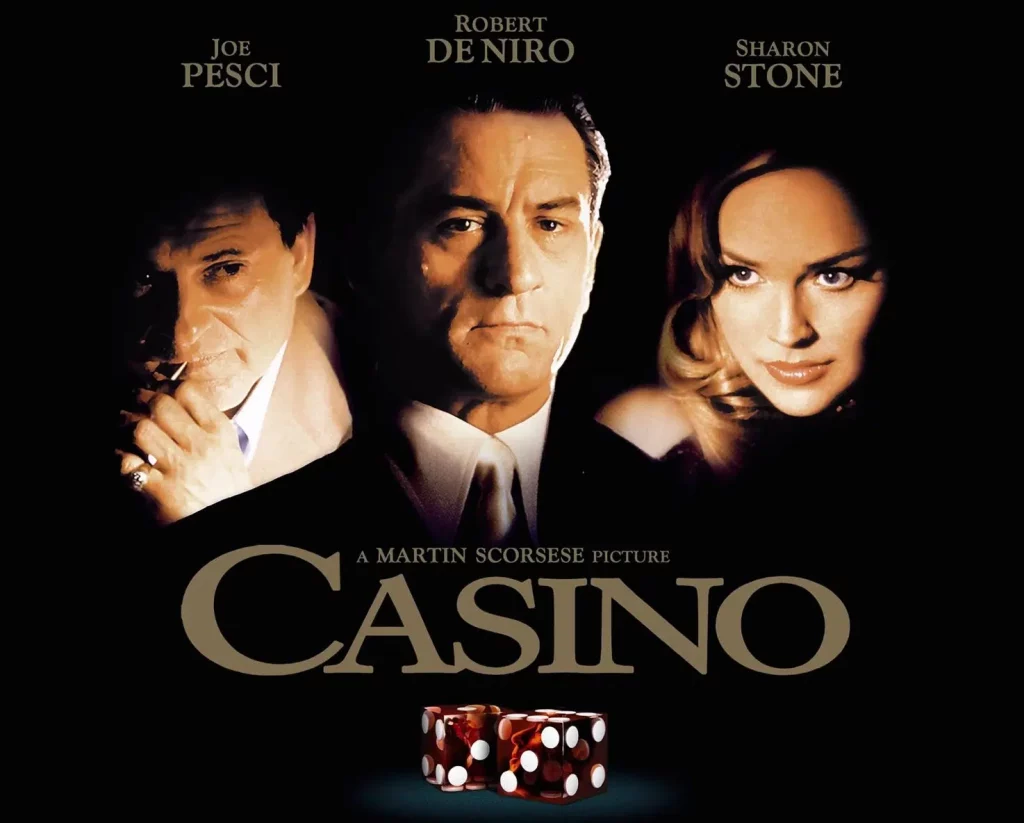
The mafia continued to hold significant influence on Las Vegas until well into the late 1990’s. With mob-connected casinos like The Thunderbird, Desert Inn, the Sands, Dunes, Riviera, Tropicana, and Stardust popping up on the Strip in the 1950’s, with major players like Jimmy Hoffa (who many believe had connections to the mob), Anthony Spilotro (a Chicago mobster), Sam Giancana (more on him later), and even Howard Hughes (who took over multiple mob-owned casinos), each exerting their influence over the city. In 1987, investigative journalist George Knapp (known today for his ongoing UFO books, documentaries, and podcasts), did a report exposing the ongoing influence of the mafia on ‘Sin City’. In fact, more recently, when a drought caused the water in Lake Mead (near the Hoover Dam) to recede, authorities began to discover dead bodies stuffed in barrels!
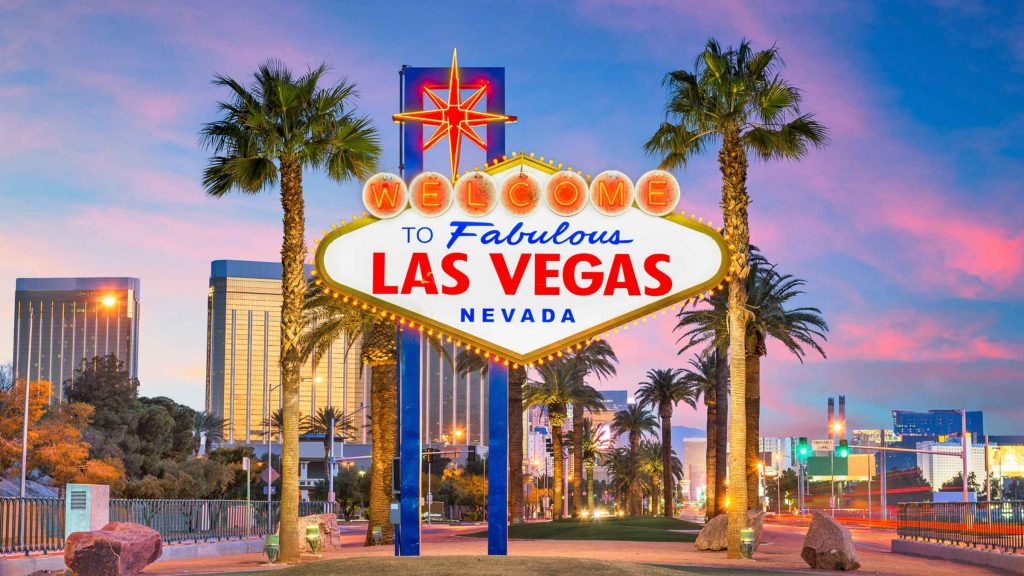
Today, there’s even a Mob Museum in what used to be the old Las Vegas courthouse! One way or another, for better or worse, the Vegas of today wouldn’t be what it is today, without Bugsy Siegel…
9 – Don Vito Genovese’s Epic Fail
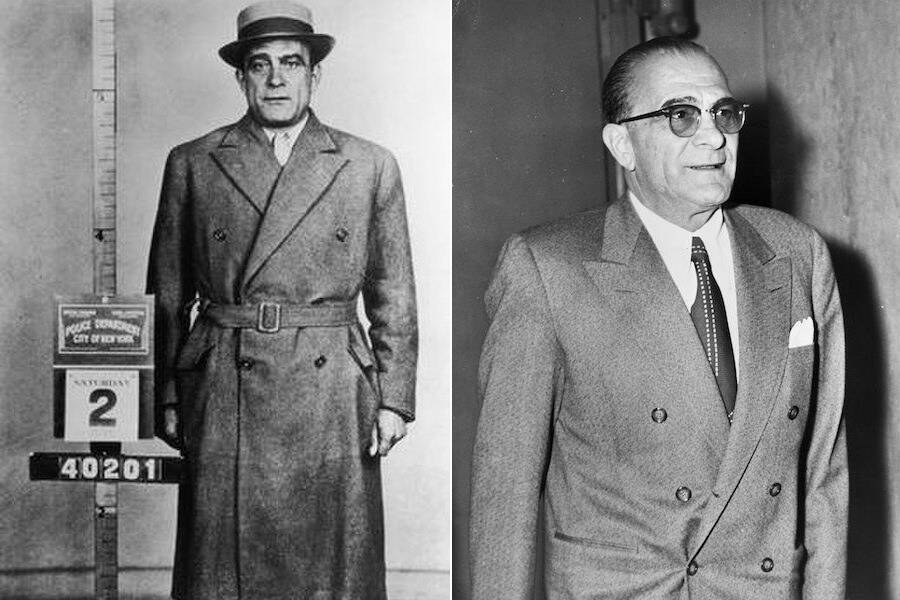
Vito Genovese was born in Naples, Italy, in 1897 before immigrating to New York as a teenager, and eventually became one of Lucky Luciano’s most trusted hitmen, working alongside Bugsy Siegel during the hit on Joe “The Boss” Masseria. His defining trait among his colleagues was his insatiable lust for power.
In 1937, he was forced to flee home to Italy, facing murder charges. Instead of laying low however, he became a close associate of Italian dictator Benito Mussolini, and even donated $250,000 to the Fascist party! That all changed when the Allies invaded in 1944, during World War II, and Vito saw the writing on the wall and switched sides at the last second. When he was hired by the US Army as an interpreter, he used the opportunity to set up a black market for stolen Army supplies!
Upon returning to the states, he found his former mob family being run by Frank Costello, so of course, he immediately started plotting a coup. On May 2nd, 1957, Vito hired Vincent “the Chin” Gigante to ambush Costello in the lobby of his apartment building. Vincent ‘The Chin’ shouted, “This is for you, Frank!” and fired. The bullet grazed Frank’s skull, but he survived the attempted hit, and took it as a sign to retire from the business, handing over control to Genovese. It wouldn’t last long though, because his enormous hubris would ultimately get the better of him.
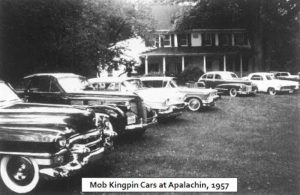 On November 14th, 1957, Don Vito called for a massive summit of mafia bosses from around the country, held in the rural town of Apalachin, New York, at a fancy estate. Little did he know, the local police soon grew suspicious as a fleet of armored Cadillacs and luxury Lincolns began winding through the countryside. In response, the local authorities set up roadblocks, and raided the mansion, causing dozens of Mafia leaders to flee into the woods! It’s considered to be the single biggest blunder in the entire history of the mob. When Vito’s car was stopped by the police, he claimed to be on the way to a barbecue and was let go.
On November 14th, 1957, Don Vito called for a massive summit of mafia bosses from around the country, held in the rural town of Apalachin, New York, at a fancy estate. Little did he know, the local police soon grew suspicious as a fleet of armored Cadillacs and luxury Lincolns began winding through the countryside. In response, the local authorities set up roadblocks, and raided the mansion, causing dozens of Mafia leaders to flee into the woods! It’s considered to be the single biggest blunder in the entire history of the mob. When Vito’s car was stopped by the police, he claimed to be on the way to a barbecue and was let go.
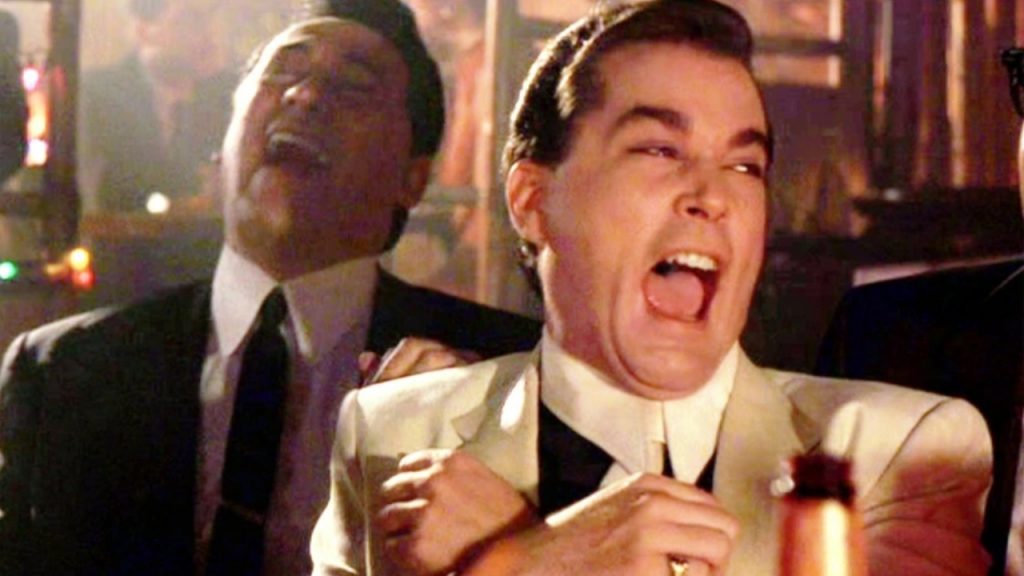
Following the ‘Apalachin Disaster’, in 1959, Vito was convicted of narcotics trafficking and sentenced to 15 years in prison. “Don Carlo” Gambino allegedly paid $100,000 to a Puerto Rican drug dealer to falsely implicate Vito, and in his absence took over the Commission from him. Even behind bars, Genovese was ordering hits from his cell, including one to take out Joe Valachi, who became the first mobster to break his oath and testified publicly about the mafia. After his death in prison, in 1969, the Genovese Crime Family became one of the most secretive, disciplined, and powerful of the “Five Families”, having learned the mistakes of their former leader.
10 – Albert Anastasia – ‘Murder Inc’
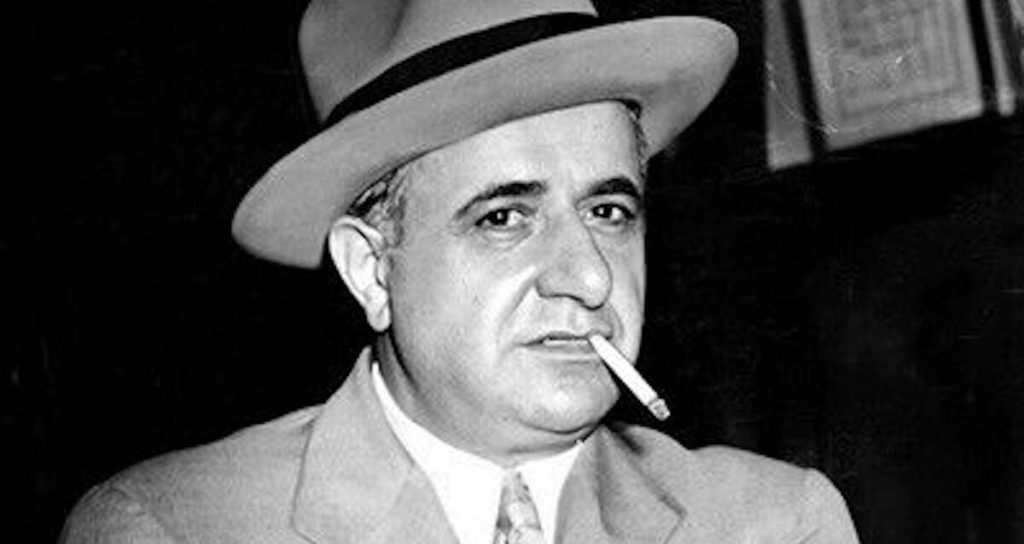
Another Italian immigrant who got his start working the Brooklyn docks, Albert Anastasia quickly became closely acquainted with Charles “Lucky” Luciano, Frank Costello, and Vito Genovese – all future Cosa Nostra bosses, in the 1920’s Prohibition-era. At one point, in 1921, he was convicted of murder and sentenced to death, but (conveniently) four of the witnesses ‘disappeared’, and the court was forced to release him from custody. Then in 1928 he was again charged for murder, but once again the witnesses either didn’t show up, or refused to testify.
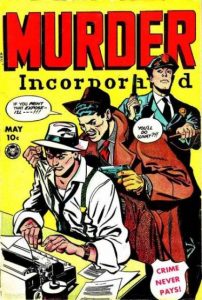 In the 1930’s, Lucky Luciana and Meyer Lansky established “Murder, Inc” to handle contract killings for the Syndicate, and Anastasia was put in charge of the operation. When a boss from Detroit or Chicago needed someone ‘removed’, they called him up, and he would solve their problem. If Luciana was the architect of the Mafia, and Lansky was its accountant, Albert Anastasia was its sword. Between the 30’s and 40’s, ‘Murder Incorporated’ took out somewhere between 400 and 700 victims for the mob. As a result, he was one of the most feared made men, even among other gangsters.
In the 1930’s, Lucky Luciana and Meyer Lansky established “Murder, Inc” to handle contract killings for the Syndicate, and Anastasia was put in charge of the operation. When a boss from Detroit or Chicago needed someone ‘removed’, they called him up, and he would solve their problem. If Luciana was the architect of the Mafia, and Lansky was its accountant, Albert Anastasia was its sword. Between the 30’s and 40’s, ‘Murder Incorporated’ took out somewhere between 400 and 700 victims for the mob. As a result, he was one of the most feared made men, even among other gangsters.
Known as “The Mad Hatter” and “Lord High Executioner”, Albert wasn’t the kinda guy you wanted to mess with. Anastasia had a strained relationship with his boss, Vincent Mangano, so when he went missing, and his brother Phillip was found shot to death under mysterious circumstances, in 1951, Anastasia took over without a second thought, declaring himself the new boss of the family. As fate would have it, Anastasia himself was then betrayed by his own underboss, “Don Carlo” Gambino (under orders from Don Vito Genovese).
On October 25th, 1957, he walked into the Barbershop at the Park Sheraton Hotel, in Midtown Manhattan, sat down in Chair #4 for a haircut and save, and was executed by two gunmen, in one of the most infamous public mob hits in history…
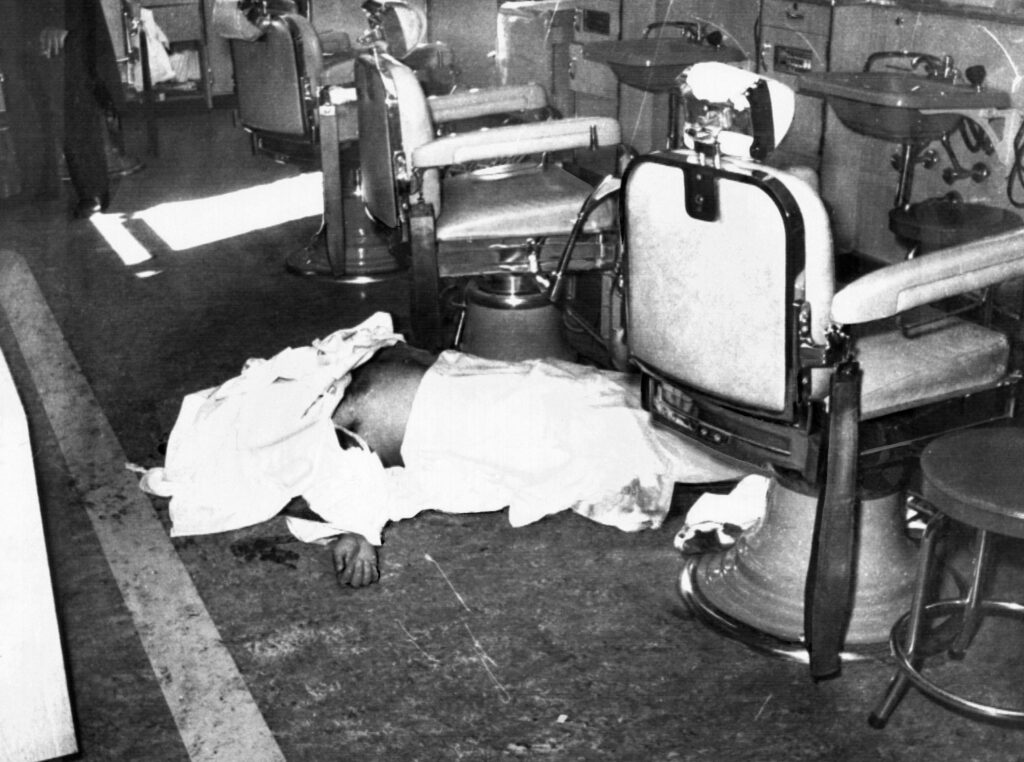
“Leave the gun. Take the cannoli.”
11 – Sam Giancana – The Mad Boss
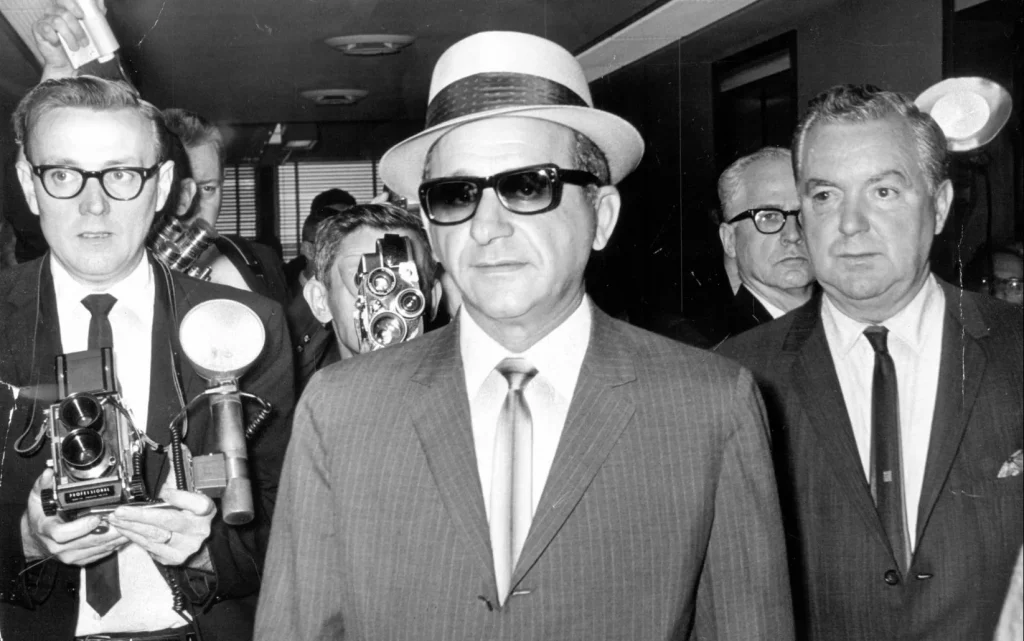
Sam Giancana got his start as a getaway driver for the “42 Gang” in 1920’s Chicago, as part of Al Capone’s bootlegging operation. When he was drafted in WWII, a psychiatrist rejected him as a “constitutional psychopath” with an “inadequate moral character” – a diagnosis that he wore as a badge of honor. By the late 1950’s, Giancana was posed to take over for his boss, Tony Accardo, and decided to modernize the Chicago Outfit under his bold leadership with international gambling and money skimming schemes in Vegas.
Unlike the previous bosses, Giancana was flashy, loud, and volatile. He flaunted his power, associated with celebrities like Frank Sinatra, and had numerous connections to government officials, and wealthy powerful figures. One of the more notorious connections was to the Kennedy family. In fact, there’s evidence to suggest that Joseph Kennedy Sr. approached the mob boss for a favor, in order to help secure the union vote in Illinois and West Virginia, for his son, John F. Kennedy, during the 1960 Presidential Election. JFK won the election by a razor-thin margin.
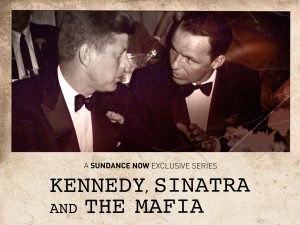 What’s even more shocking is that JFK and Sam Giancana even shared a girlfriend, Judith Campbell Exner, who allegedly acted as a courier, carrying envelopes between the President and the most powerful mobster in Chicago! The cozy relationship with the Kennedy’s turned sour, however, when JFK appointed his brother, Robert F. Kennedy as Attorney General, and RFK unexpectedly launched the most aggressive war on organized crime in American history, with Sam Giancana as the primary target! In response, Giancana shouted, “I broke my back for that guy!”
What’s even more shocking is that JFK and Sam Giancana even shared a girlfriend, Judith Campbell Exner, who allegedly acted as a courier, carrying envelopes between the President and the most powerful mobster in Chicago! The cozy relationship with the Kennedy’s turned sour, however, when JFK appointed his brother, Robert F. Kennedy as Attorney General, and RFK unexpectedly launched the most aggressive war on organized crime in American history, with Sam Giancana as the primary target! In response, Giancana shouted, “I broke my back for that guy!”
Somewhat ironically, around the same time, the CIA reached out to the Mafia for help in their repeated (failed) attempts to assassinate Fidel Castro, prior to the (botched) Bay of Pigs Invasion and the Cuban Missile Crisis that followed. The leadership at the CIA (under Allen Dulles) figured that the mob lost millions when Castro closed down their Havana casinos, and would be eager to retake their territory. Sam Giancana agreed to help the CIA with Operation Mongoose, refusing payment as a patriot. The plots to kill Castro included sniper rifles, poison pills, and even an exploding cigar, but each and every attempt failed.
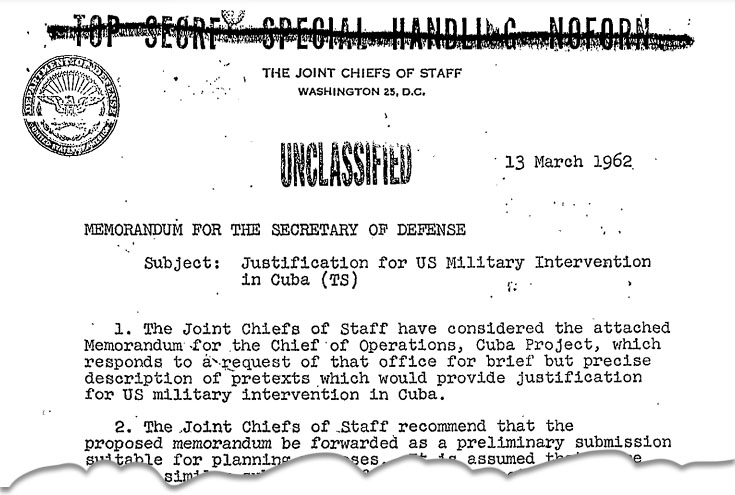
Between the Chicago mob’s close ties to JFK, the CIA, and Cuba, Giancana has become a prime suspect among conspiracy theorists as one of the architects behind the Assassination of John F. Kennedy, which took place in Dallas, Texas, on November 22nd, 1963, but unfortunately, the full story remains a mystery to this day, since thousands of government’s files on the case are still classified, over 60 years later.
The ‘Old Guard’ of the Chicago Outfit started to see Sam as a liability, constantly making headlines between his public affairs, and in 1966, after he was jailed for contempt of court, they stripped him of his power, and sent him to exile in Mexico. Then, in 1974, the US Senate’s ‘Church Committee’ summoned him to testify about his involvement in the Castro plots with the CIA. Before he testified however, he was taken out by one of his own men.
On June 19th, 1975, Giancana was in his basement kitchen, at his Oak Park home, cooking peppers and sausage when the killer shot him in the back of the head, using a silenced .22 caliber pistol. According to the crime scene forensics, he was then turned over and shot six more times in the mouth – a traditional mafia message: he talked too much…
12 – Richard “The Iceman” Kuklinski
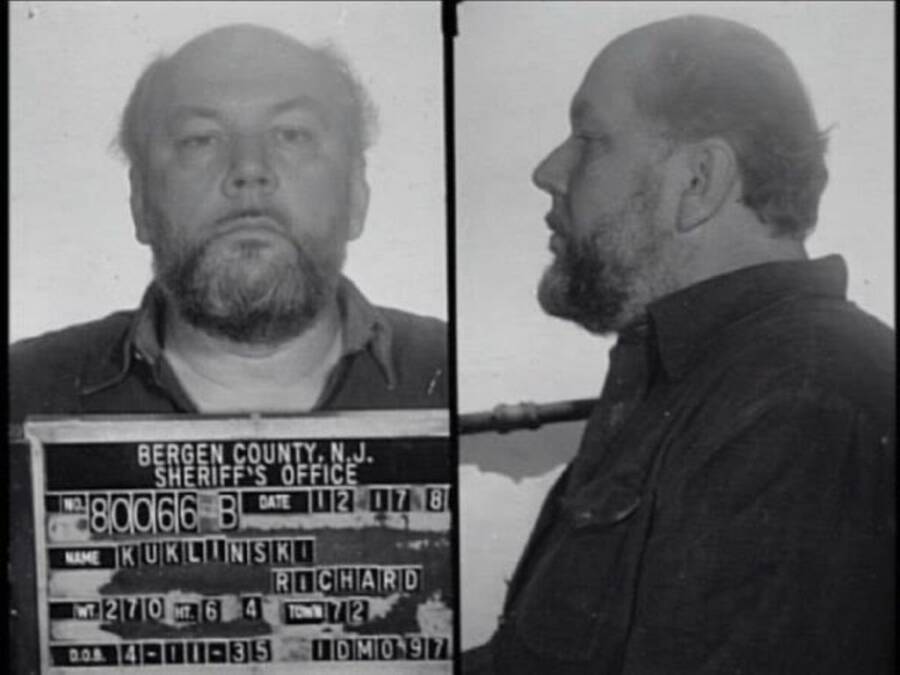
Richard Leonard “The Iceman” Kuklinski was one of the most prolific serial killers of the 20th Century, who worked for a contract killer for the mob, while maintaining a double-life as a loving husband and father from New Jersey, for over 30 years!
Born in 1935, Kuklinski’s childhood was marked by extreme physical abuse which he later blamed for his cold, detached nature. He had a violent temper and claimed to have killed his first man in his early teens. He quickly became a notorious figure in the criminal underworld for his immense size and formidable strength, weighing in at 300 pounds and standing at 6’5! He soon took notice of the East Coast Mafias, working as an enforcer and hitman for the Gambino family, and Don Genovese. While many of his murders were for money, he also killed a number of people to settle personal debts, or in a fit of rage. The most shocking part however is that he was actively living a secret life as a contract killer by night, and family man by day – the entire time!
 He didn’t just kill his victims, he made an art out of it, testing different methods over the years from guns and knives to blunt objects and icepicks, but was particularly fond of liquid cyanide – a quick silent killer that mimicked a heart attack. “The Iceman” earned his chilling nickname due to his unique method of covering up his crimes – by freezing the bodies of his victims in industrial freezers, storing them for years before dumping them, which would throw off forensics. However, one medical examiner found ice crystals in the tissues of one of his mob hits, Louis Masgay. Kuklinski was finally caught in 1986, after an elaborate undercover investigation.
He didn’t just kill his victims, he made an art out of it, testing different methods over the years from guns and knives to blunt objects and icepicks, but was particularly fond of liquid cyanide – a quick silent killer that mimicked a heart attack. “The Iceman” earned his chilling nickname due to his unique method of covering up his crimes – by freezing the bodies of his victims in industrial freezers, storing them for years before dumping them, which would throw off forensics. However, one medical examiner found ice crystals in the tissues of one of his mob hits, Louis Masgay. Kuklinski was finally caught in 1986, after an elaborate undercover investigation.
Richard ‘The Iceman’ Kuklinski was suspected of dozens of homicides, but was only convicted on 4 murders in 1988, later pleading guilty to a fifth, receiving two consecutive life sentences. However, during extensive interviews with criminologists, psychiatrists, and documentary filmmakers, he claimed to have brutally murdered somewhere between 100 and 250 people during his time as a hitman for the mob. He died in prison at the age of 70, in 2006. He remains as one of the most studied examples of a high-functioning sociopath masquerading as an everyday family man from Jersey…
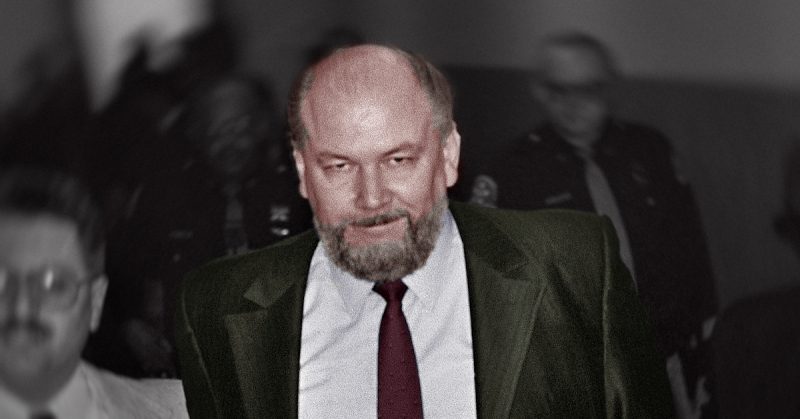
The face of evil.
13 – John Gotti, “The Teflon Don”
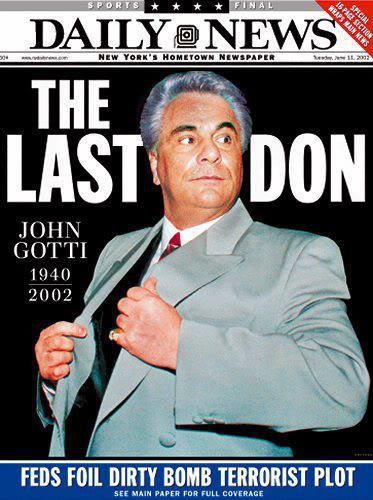
John Joseph Gotti Jr. was the last major mob boss of the 20th Century, as the head of New York’s Gambino Crime Syndicate, and his end signaled the end for the American mafia itself.
John Gotti was born to an Italian family in the Bronx in 1940, where he and his brothers grew up in poverty. John resented his father for not being able to provide for the family, he had a reputation as a bully growing up, and by the age of 12 had joined a street gang, and once attempted to steal a cement mixer, but crushed his toes in the process, leaving him with a permanent limp. After dropping out of school, Gotti began running errands in Brooklyn, for Carmine Fatico, a soldier for the Anastasia family. At a bar in 1958, Gotti met the half-Italian, half-Russian love of his life, Victoria DiGiorgio, whom he married in 1962. He briefly attempted to go straight as a presser in a coat factory, but eventually got pulled back in.
 He befriended fellow mobster, Joseph Massino, while carrying out truck hijackings at New York’s International Airport, and earned the nicknames “Black John” and “Crazy Horse”. Around the same time he met his mentor, Gambino underboss Aniello “Neil” Dellacroce. After his third stint in prison (for stealing a shipment of cigarettes), he was paroled in 1972 and became an enforcer for an illegal gambling operation. Following Mob Boss Carlo Gambino’s nephew’s murder, Gotti was assigned to a hit squad to get revenge against the main suspect, James McBratney. Unfortunately, the crew completely botched the operation while attempting to kidnap him at a Staten Island bar, disguised as detectives, when one of them shot the man. After being released from prison in 1977, John Gotti was officially inducted into the Gambino Crime Family as a “Made Man”, by Carlo’s successor, Paul Castellano.
He befriended fellow mobster, Joseph Massino, while carrying out truck hijackings at New York’s International Airport, and earned the nicknames “Black John” and “Crazy Horse”. Around the same time he met his mentor, Gambino underboss Aniello “Neil” Dellacroce. After his third stint in prison (for stealing a shipment of cigarettes), he was paroled in 1972 and became an enforcer for an illegal gambling operation. Following Mob Boss Carlo Gambino’s nephew’s murder, Gotti was assigned to a hit squad to get revenge against the main suspect, James McBratney. Unfortunately, the crew completely botched the operation while attempting to kidnap him at a Staten Island bar, disguised as detectives, when one of them shot the man. After being released from prison in 1977, John Gotti was officially inducted into the Gambino Crime Family as a “Made Man”, by Carlo’s successor, Paul Castellano.
Castellano was intent on focusing on ‘white collar crime’, while Gotti and his associates grew frustrated with his leadership. When members of Gotti’s crew were indicted for selling narcotics, specifically heroin, they got paranoid that the boss would throw them under the bus. John decided to take him out first. On December 16th, 1985, Castellano met with several mobsters at Sparks Steak House in Manhattan where he was ambushed, and shot by assassins under Gotti’s command, while he watched from his car, and he was quickly appointed as the new boss, breaking decades of strict mafia protocol in the process. It was a spectacular public execution, that shook the mob world to its core, and ushered in a new era under Gotti’s ruthless leadership.
As the new boss he became known as “The Dapper Don” due to his flashy public image, often wearing expensive suits, smiling and waving at cameras, and drawing attention to himself, rather than operating from the shadows like the previous regimes, which would of course be his eventual undoing. Despite his operating out in the open, John Gotti was notoriously difficult to convict. He faced three major trials, with each ending in acquittals or mistrials.
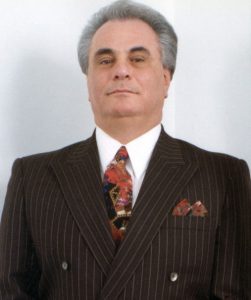 In 1986 he was accused of assault and battery, but a key witness for the prosecution was (conveniently) determined to be a “pathological liar” by the jury. Behind the scenes, Gotti’s accuser claimed “he was unable to remember who attacked him”, after a series of threatening phone calls, and having his brake lines severed. In 1987 Gotti was acquitted on Racketeering and Conspiracy charges (along with loansharking, illegal gambling, truck hijackings, and murder), but it was later revealed that the jury foreman had been bribed by the Don’s organization. He was once again acquitted in 1990 for assault. All of this led to the media referring to him as “The Teflon Don”, because it seemed as though nothing they threw at him would stick.
In 1986 he was accused of assault and battery, but a key witness for the prosecution was (conveniently) determined to be a “pathological liar” by the jury. Behind the scenes, Gotti’s accuser claimed “he was unable to remember who attacked him”, after a series of threatening phone calls, and having his brake lines severed. In 1987 Gotti was acquitted on Racketeering and Conspiracy charges (along with loansharking, illegal gambling, truck hijackings, and murder), but it was later revealed that the jury foreman had been bribed by the Don’s organization. He was once again acquitted in 1990 for assault. All of this led to the media referring to him as “The Teflon Don”, because it seemed as though nothing they threw at him would stick.
That all changed however when the FBI managed to wiretap his HQ in Little Italy, the Ravenite Social Club. Through their carefully placed bugs, the Feds captured hors of Gotti speaking openly about his various murders, as well as detailing the inner workings of his vast operation, car bombings, hit jobs, witness tampering, the works, but the nail in the coffin was his own underboss turned rat, Salvatore “Sammy the Bull” Gravano, who turned state’s evidence, and testified against the Teflon Don about his direct involvement in five murders, including the hit on Castellano.
Finally, in 1992, John Gotti was convicted on all counts, including: five murders, illegal gambling, racketeering, obstruction of justice, and of course tax evasion. He was promptly sentenced to life in prison without the possibility of parole, and eventually died of throat cancer in 2002, behind bars. In the wake of the Don’s death, New York attorney, James Comey, spearheaded the prosecution of 14 more alleged members of the Gambino crime family on charges of robbery, extortion, and murder, effectively ending the mob’s reign.
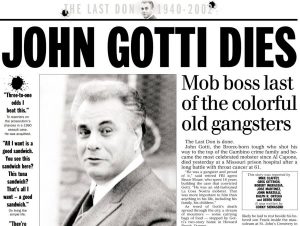
Years later, after being appointed as the Director of the FBI by President Barack Obama in 2013, and then unceremoniously removed from his position by President Donald J. Trump in 2017. James Comey compared Trump to a Cosa Nostra crime boss in his book, “A Higher Loyalty”, warning that he operated both his businesses and the government like the mafia – and if anyone would know, it would be the guy who took down America’s biggest crime syndicate…
Ultimately, each of these crime stories serves as a cautionary tale about how unchecked greed can quickly turn the American Dream into a bloody nightmare.
Erik Slader

